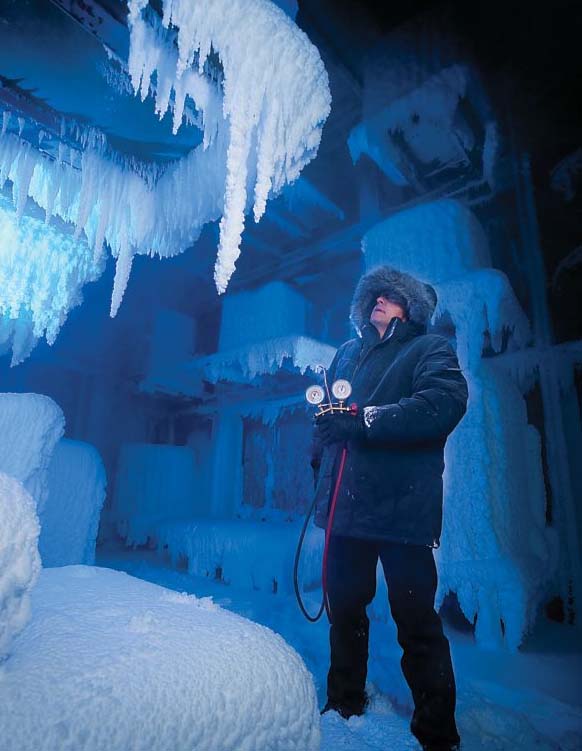Trane Technologies announced that it has surpassed U.S. Department of Energy (DOE) requirements for the residential Cold Climate Heat Pump (CCHP) Challenge for high-efficiency heating in freezing temperatures. After outperforming laboratory tests in extremely cold temperatures, Trane’s high-efficiency CCHP will begin field trials later this month.
DOE’s CCHP Challenge was designed to support reducing energy demands and carbon emissions in the U.S. through the use of electricity-driven heat pumps instead of fossil-fuel-fired space heating appliances. The goal of the Challenge was to increase the performance of heat pumps at cold temperatures, increase heating capacity at lower ambient temperatures, and offer more efficiency across a broader range of operating conditions.
Trane accepted the Challenge and is well on its way to delivering a CCHP within the timeframe established by the DOE.
Vice president of engineering and technology of residential HVAC
Trane Technologies
Lab Results

COLD TESTS: Lab tests for Trane’s CCHP prototype were performed at the DOE’s Oak Ridge National Lab Facility in temperatures as low as -23°F. (Courtesy of Trane)
Lab tests for Trane’s CCHP prototype were performed at the DOE’s Oak Ridge National Lab Facility in temperatures as low as -23°F, which surpassed the mandatory -20°F DOE requirement. Even as temperatures moved beyond the trial scope, the prototype continued to operate at a high performance level; in fact, in order to stop the unit, researchers had to manually cut the power, said Katie Davis, vice president of engineering and technology of residential HVAC, Trane Technologies.
“Passing the lab testing phase means we’re now able to conduct field testing with this heat pump, which will provide us with the opportunity to keep a family warm this winter,” she said. “What’s more, is that getting to this phase in the Challenge ultimately brings us one step closer to seeing through the commercialization of our CCHP to better meet the heating needs of homeowners today and boldly challenge what’s possible for a more sustainable world in the future.”
Under DOE’s CCHP Challenge, a heat pump 4 tons and lower must have a COP of 2.4 while providing 100% of nominal rated capacity at an ambient temperature of 5°F (see Table 1). A heat pump larger than 4 tons must have a COP of 2.1 with the same nominal capacity requirement at 5°F. In addition, the heat pump must have an HSPF2 of 8.5 in Climate Zone 5. There are no products on the market that currently meet these performance specifications.

TABLE 1: CCHP performance requirements at 5°F. (Courtesy of DOE)
“There are several approaches to improving a heat pump’s performance in cold climates, including but not limited to cascade refrigeration systems, various forms of multi-stage compression, vapor-injection, and liquid injection,” said Davis. “The optimal solution will consider the trade-off between customer needs, product cost, operational efficiency, reliability, and technology readiness. It’s all about maximizing value for our customers while meeting their comfort needs.”
In addition, the units must use a refrigerant that has a GWP of no more than 750, per the requirements of the Challenge. Trane’s CCHP units will utilize the A2L refrigerant, R-454B, which has a GWP of 466.
Field Tests
Now that Trane has completed the lab portion of testing, the company will begin field testing its CCHP in Boise, Idaho, later this month. The prototype will be placed under cold climate ambient operating conditions in a residential application.
“A successful field test is performance during the heating season in extremely cold conditions, delivering energy-efficient heating capacity to meet the building load,” said Davis. “Simply stated, providing energy-efficient heating in extremely cold temperatures in a residential application.”
DOE may decide to extend the field trial testing into a second heating season, and if that is the case, Trane will participate in the second field trial in 2023. If field trial testing concludes in 2022, the company will continue toward commercialization of the product.
Today’s Options
Until Trane’s CCHP is available for purchase, the company will continue to provide highly efficient options, such as heat pumps, more environmentally minded furnaces, and the pairing of the two in dual-fuel systems, said Davis.
“As more and more homeowners choose sustainable solutions such as heat pumps — and likewise, are becoming increasingly aware of the governmental perks and tax rebates to reduce fossil fuels — we look forward to helping them take advantage of new clean energy tax credits and rebates available through the Inflation Reduction Act, which includes a substantial expansion of the Energy Efficiency Home Improvement Tax Credit (25C) as well as an extension and expansion to the New Energy Efficient Home Tax Credit (45L),” she said.
Trane’s highly efficient heat pump offerings including the Platinum XV20i heat pump, which is part of a new line of equipment featuring Trane Link, a new communication technology that is designed to simplify installation, commissioning, and remote monitoring of Trane’s variable-speed HVAC systems. Following a regional launch in spring 2022, the full line of Trane Link equipment will be available for Trane’s independent dealers to order nationwide beginning this month, said Davis.
As for when Trane’s new CCHP will be available commercially, that remains to be seen. However, it won’t be too much longer, as the Challenge sets out a deadline of 2024 for the availability of the new heat pumps.
“We are confident that we will achieve the goals of the Cold Climate Heat Pump Challenge,” said Davis. “At Trane Technologies, we challenge possible.”



Report Abusive Comment